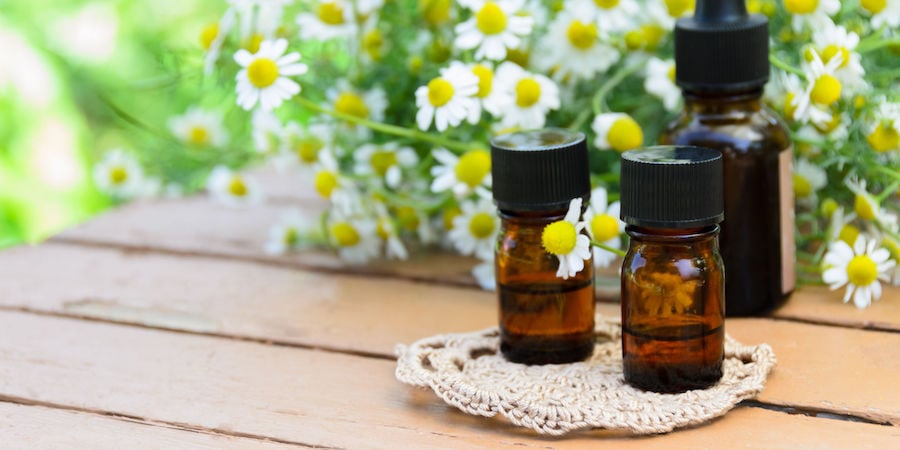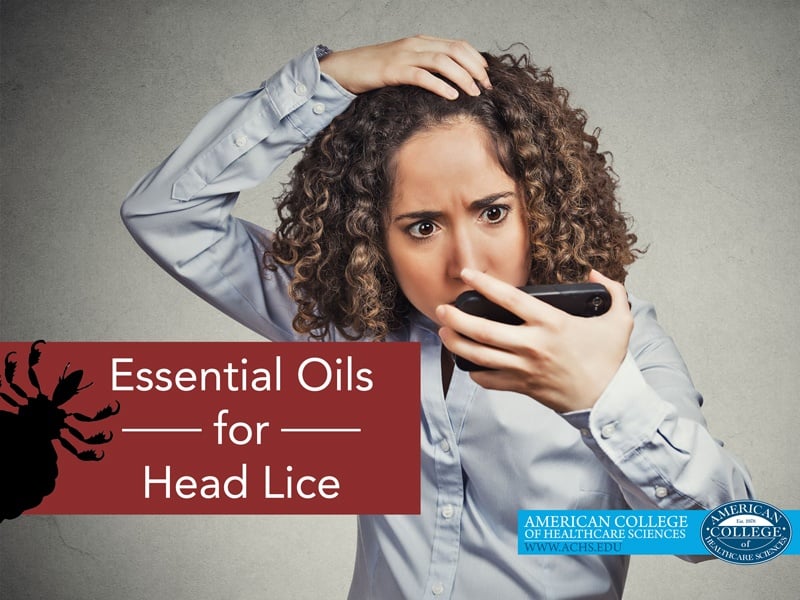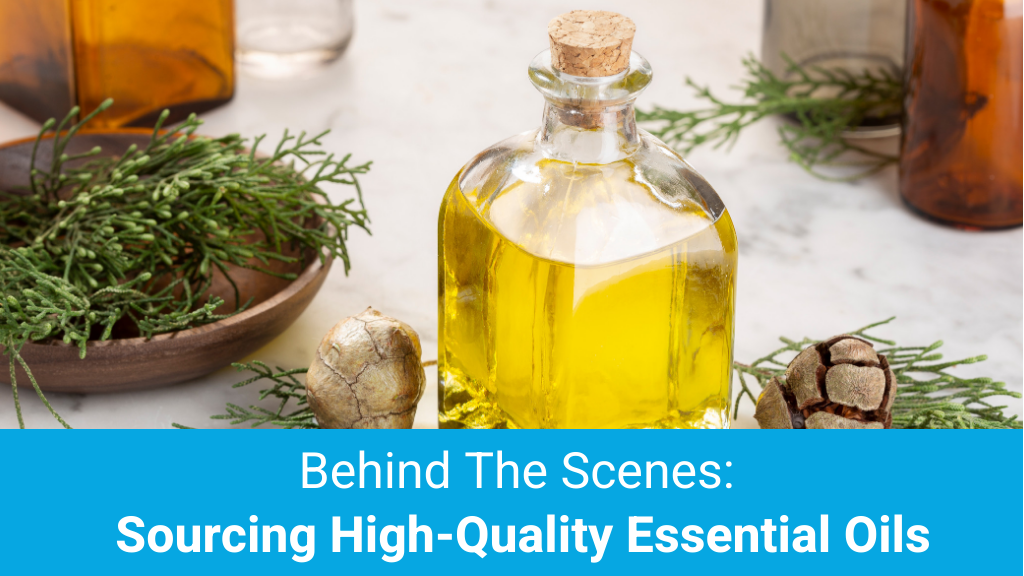The Art of Choosing Quality Oils
Isn't it nice to go wine tasting? If you’re like me, you might choose a family owned vineyard known for organic and responsible farming. When you know exactly where and how the fruit is grown, you're going to get some tasty wine. Similarly, when practicing aromatherapy, every Registered Aromatherapist (RA) should be working with the best oils to achieve the desired therapeutic effects.
The aromatherapist’s "nose" is one of the tools used to identify extenders, diluents, and synthetics—all things that can be used to adulterate essential oils. Just like a fine glass of wine, it’s important to be able to sniff out those adulterants. But not to worry—there are a number of ways you can evaluate the quality of an essential oil. Here are some key tips to ensure you are using the best oils that will produce the most effective results:
What to Look For
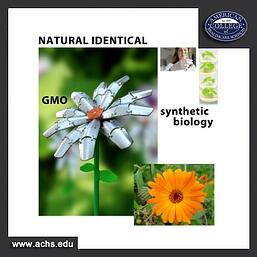 Just as if you were wine tasting, you want to make sure your bottle of essential oil contains only the essential oil. Diluents are substances that are usually odorless and are added to the products for commercial reasons, while extenders are inexpensive aroma materials that may or may not have an identical fragrance and are usually synthetic.
Just as if you were wine tasting, you want to make sure your bottle of essential oil contains only the essential oil. Diluents are substances that are usually odorless and are added to the products for commercial reasons, while extenders are inexpensive aroma materials that may or may not have an identical fragrance and are usually synthetic.
One phrase to look out for is: “nature identical.” This should be a red flag, and usually refers to a chemically synthesized version of the oil. Nature identical, diluted, or extended oils should not be used for clinical aromatherapy. Nature identical oils—or the use of single synthetic constituents—do not account for the synergistic actions of whole plant oil (don’t worry, I’ll discuss the idea of “synergy” in the next section).
And did you know that genetically modified (GMO) sourcing doesn't apply solely to food? GMO-sourced fragrance and flavor materials created using synthetic biology—something we are seeing more of in the world of fragrance and flavor are also unsuitable for clinical aromatherapy.
The Power of Synergy
Another important term and concept every aromatherapist should know is "synergy." Loosely translated, synergy means “working together,” and is based on the idea that the whole is greater than the sum of the parts. A bicycle is a good example of synergy; each part is necessary for the whole bike to work. Imagine taking away one of the wheels or dismantling the break cables—you won’t be cycling anywhere. Synergy exists between the constitunets within individual essential oils and also within blends of specific oils.
A useful example of how synergy works in essential oils can be seen in a 1974 study. The study focused on Eucalyptus citriodora (Hook.), which showed more effective antimicrobial activity (active against microorganisms such as bacteria) in the whole oil than in the separate components, citronellal and citronellol.[1] Another study in 1993 focused on the antifungal activity of limonene. Sweet orange Citrus sinensis (Osbeck) was found to have strong antifungal activity against fungi, such as Aspergillus niger. [2] Limonene was separated from the oil and found to be the antifungal constituent, but it was less active than the whole oil: the whole was greater than the individual parts. It was found that the presence of other constituents, even in low proportions, created a synergistic effect, enhancing the overall antifungal activity.[3] 
There’s also power in blends! Synergy is also a factor when aromatherapists blend essential oils for clinical therapy. Research has shown greater antimicrobial activity when oils are combined. One study showed this to be the case even when some of the oils showed no activity on their own.[4]
In addition to the benefits of synergy, a supplier may be unaware that diluted or extended oils can pose problems for the clinical aromatherapist where oils may be used on the skin or administered internally. This is why it is even more crucial that Registered Aromatherapists know how to test the qualities of essential oils.
Dangerous Diluents
Diluents such as diethyl phthalate (DEP), for instance, can cause toxic reactions when administered orally or topically. DEP is made from ethanol and phthalic acid and is a permitted substance in fragrance products where skin contact is minimal. However, an essential oil is not safe to use when DEP is present for the administration of clinical aromatherapy. DEP may even have cancer-causing effects.[5] A 2010 study found that, in women with breast cancer, a urinary metabolite (Monoethyl phthalate [MEP]) of the parent compound DEP was elevated.[6] Aromatherapists are trained in organoleptic testing—a method of testing oils by using the five senses—to help identify potential adulterants and extenders. This testing exposes DEP by identifying its bitter and unpleasant taste, which is also irritating to mucous membranes.
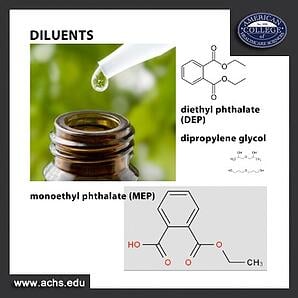
Aromatherapists are taught that DEP is most often found in sandalwood Santalum album (L.), and benzoin Styrax paralleloneurum (Perk.) oils, but may also be found in other oils. One simple test for DEP that is recommended is to put a single drop of the oil on the tip of the tongue. If the oil contains DEP, the tongue will feel numb. However, aromatherapists are trained to recognize that the eugenol content of oils, such as rose Rosa damascena (Mill.) oil, can also make the tongue numb and does not mean the oil is adulterated in this case.
Evasive Extenders
Extenders are even more problematic because they come in disguise! They mimic the natural chemical compound found in essential oils—however, they produce effects that the natural oil would not produce and consequently they are metabolized quite differently. This means they are not going to behave in the body as expected.
Keep an eye (or a nose!) out for how some unsavory producers use extenders; some examples include lavender Lavandula angustifolia (Mill.) adulterated with synthetic or naturally sourced linalyl acetate, linalol, and other synthetically duplicated substances; chamomile Chamaemelum nobile (L.) oil enhanced by adding synthetic azulene; and rose otto R. damascena adulterated with rhodinol.
Oils with that have had a fixed or fatty oil added are also unacceptable to use in clinical aromatherapy. Aromatherapists are trained to test for this by rubbing a small sample of the essential oil between the thumb and middle finger or dropping the oil on a perfume-testing blotter. An extended oil will feel slick or even slimy, leave a greasy spot on the testing strip, and will not evaporate completely.
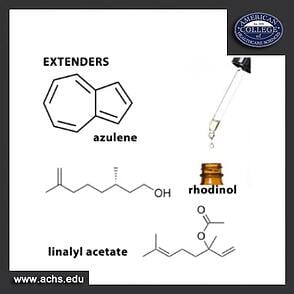
Rancidity is another factor that aromatherapists are alerted to. While most essential oils will alter over a long period, they do not become rancid or produce the rancid odors of a vegetable or fixed oil. If your essential oil smells rancid, it is most likely because a base or fixed oil has been added to the essential oil and has spoiled. Liquids, such as alcohol, are also not suitable for clinical aromatherapy when used to adulterate oils.
Find the Right Training
Here at the American College of Healthcare Sciences, our clinical aromatherapy graduates are trained to inspect oils for signs of impurity when in a crystallized state. Oils such as anise Pimpinella anisum (L.) and rose R. damascena reveal a lot with this simple test. Both oils solidify and crystallize in cool temperatures. When crystallized, adulterated oils will reveal the adulterating substance, which either rests on the bottom or floats on top. This is a great test since solidified or crystallized oils kept at room temperature for a few hours will liquefy with no damaging effects to the oil.
As you can see, there are a number of ways you can evaluate the quality of an essential oil. ACHS recommends formal training in aromatherapy or working with Registered Aromatherapist (RA) before using essential oils for therapeutic use. Both for safety and to maximize results, be sure you have appropriate training to use essential oils.
Now that you know a few key tools for checking the quality of essential oils, be sure to check back soon for my next blog article in this series: “Quality of Essential Oils: Top 5 Ways to Check Quality of Essential Oils: Gas Chromatography (GC), Mass Spectometry (MS), Latin, Organoleptic Testing, & Knowing Your Supplier”!
What are your favorite strategies for purchasing the best essential oils? Leave a comment to let us know!
Click the button below for free offers, fun eBooks, and information about the American College of Healthcare Sciences accredited online programs!
This article is for informational purposes only. It is not intended to treat, diagnose, cure, or prevent disease. This article has not been reviewed by the FDA. Always consult with your primary care physician or naturopathic doctor before making any significant changes to your health and wellness routine.
[1] Low D., Rawal B.D., & Griffin W.J. (1974). Antibacterial action of the essential oils of some Australian Myrtaceae with special references to the activity of chromatographic fractions of oil of Eucalyptus citriodora. Planta Med., 26, 184-189.
[2] Singh, G., Upadhyay, R.K., Narayanan, C.S., Padmkumari, K.P., & Rao, G.P. (1993). Chemical and fungitoxic investigations on the essential oil of Citrus sinensis (L.) Pers. J. Plant Disease and Protection, 100, 69-74.
[3] Ibid.
[4] Geda, A.K. (1995). Antibacterial activity of essential oils and their combinations. Fat Sci Technol., 97, 458-460.
[5] López-Carrillo, L., Hernández-Ramírez, R.U., Calafat, A.M., Torres-Sánchez, L., Galván-Portillo, M., Needham, L.L., Ruiz-Ramos, R., et al. (2010). Exposure to phthalates and breast cancer risk in northern Mexico. Environ Health Perspect,118, 539-44.
[6] Ibid.




